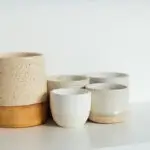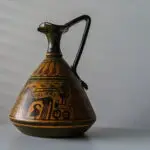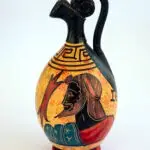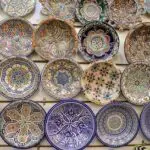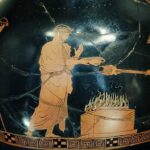Mediterranean pottery is renowned for its intricate styles and techniques. Ancient Greeks excelled in pottery, inspiring modern artists. It served practical and decorative purposes, featuring intricate designs.
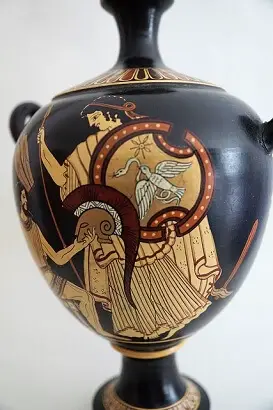
The black-figure technique, popular in 7th-century BCE Athens and Corinth, involved black-painted figures on a reddish-orange background. Another technique, the red figure, emerged in 6th-century BCE Athens, with black backgrounds and natural clay colors for figures. Skilled potters shaped clay into vases, bowls, and more.
During the 8th century BCE, geometric patterns dominated, evolving into detailed human figures and mythological scenes. The legacy of ancient Greek pottery endures, showcasing their skill and creativity.
Techniques Used in Mediterranean Pottery
Mediterranean pottery is known for its unique styles and techniques. The techniques used in Mediterranean pottery have evolved over time, and have been influenced by various factors such as geography and cultural exchange. In this section, we will explore the various techniques used in Mediterranean pottery.
Firing
Firing is the process of heating the pottery to a high temperature to make it hard and durable. In Mediterranean pottery, firing is done in a kiln, which is a special oven used for firing pottery. The kiln can be fueled by wood, charcoal, or gas, depending on the availability of resources. The temperature of the kiln can also vary depending on the type of pottery being fired. For instance, red-figure pottery is fired at a lower temperature than white pottery.
Design
Design is an important aspect of Mediterranean pottery. The designs on the pottery can be created using various techniques such as sgraffito, incised, and glazing. Sgraffito is a technique where the design is scratched into the surface of the pottery. An incision is a technique where the design is cut into the surface of the pottery. Glazing is a technique where a layer of glass is applied to the surface of the pottery to create a shiny and colorful surface.
Texture
The texture is another important aspect of Mediterranean pottery. The texture of the pottery can be created using various techniques such as smoothing, polishing, and ribbing. Smoothing is a technique where the surface of the pottery is made smooth by rubbing it with a stone or other hard material. Polishing is a technique where the surface of the pottery is made shiny by rubbing it with a cloth or other soft material. Ribbing is a technique where the surface of the pottery is given a ridged texture by using a ribbing tool.
Shapes
The shapes of Mediterranean pottery can vary greatly depending on the region and the time period. Some common shapes include bowls, kraters, cooking pots, and storage jars. The shapes of the pottery can also be influenced by the function of the pottery. For instance, storage jars are typically large and round to accommodate a large amount of food or liquid.
In conclusion, Mediterranean pottery is known for its unique styles and techniques. The techniques used in Mediterranean pottery have evolved over time and have been influenced by various factors such as geography and cultural exchange. Firing, design, texture, and shapes are all important aspects of Mediterranean pottery that contribute to its beauty and durability.
Styles of Mediterranean Pottery
Mediterranean pottery has a rich history, with various styles and techniques evolving over time. This section will explore the most significant styles of Mediterranean pottery, including the Geometric Style, Black-Figure Style, Red-Figure Style, Corinthian Style, and Classical Style.
Geometric Style
The Geometric Style is the earliest known style of Greek pottery, dating back to the 9th century BCE. This style is characterized by geometric shapes and patterns, such as triangles, circles, and zigzags, painted in black on a light-colored background. The pottery was often used for funerary purposes and was decorated with scenes of animals, humans, and mythical creatures.
Black-Figure Style
The Black-Figure Style emerged in the 7th century BCE and was used until the 5th century BCE. This style was characterized by black figures painted on a red background, with details incised into the clay. The figures depicted scenes from mythology and everyday life, and the pottery was often used for storage and transport.
Red-Figure Style
The Red-Figure Style was developed in the late 6th century BCE and was used until the 4th century BCE. This style was a reversal of the Black-Figure Style, with the background painted black and the figures left in the natural color of the clay. This style allowed for more intricate details and shading, and the pottery was often used for decorative purposes.
Corinthian Style
The Corinthian Style emerged in the 7th century BCE and was used until the 5th century BCE. This style was characterized by intricate patterns and animal motifs, such as lions, panthers, and sphinxes, painted in black on a light-colored background. The pottery was often used for funerary purposes and was exported throughout the Mediterranean.
Classical Style
The Classical Style emerged in the 5th century BCE and was used until the 4th century BCE. This style was characterized by a focus on naturalism and realism, with scenes from mythology and everyday life depicted in great detail. The pottery was often used for decorative purposes and was highly prized by collectors.
In conclusion, Mediterranean pottery has a rich history with various styles and techniques evolving over time. The Geometric Style, Black-Figure Pottery, Red-Figure Technique, Corinthian Style, and Classical Style are some of the most significant styles of Mediterranean pottery. Each style has its own unique characteristics and was used for different purposes.
Designs and Decoration of Mediterranean Pottery
Mediterranean pottery is known for its intricate designs and decorations that are representative of the culture and traditions of the region. The designs and decorations on Mediterranean pottery are a reflection of the artistic sensibilities of the people who created them. These designs and decorations were used to tell stories, depict important events, and showcase the beauty of the region.
Nature and Animals
One of the most common themes found in Mediterranean pottery designs is nature and animals. The designs often depict flowers, leaves, and trees, which are representative of the flora of the region. Animals such as fish, birds, and lions are also commonly depicted on Mediterranean pottery. These designs not only showcase the beauty of nature but also represent the importance of nature in the lives of the people who created them.
Gods and Demons
Another common theme found in Mediterranean pottery designs is gods and demons. The designs often depict gods and goddesses from the mythology of the region. These designs were used to pay homage to the gods and goddesses and to seek their blessings. Demons and other mythical creatures were also commonly depicted on Mediterranean pottery. These designs were used to ward off evil and protect the people who used the pottery.
Lists and Signatures
Lists and signatures are also commonly found on Mediterranean pottery. These designs often include the names of the people who created the pottery, the date it was made, and the place where it was made. These designs are important because they help to identify the origin of the pottery and provide information about the people who created it.
Women and Men
Mediterranean pottery designs also often depict women and men. These designs are representative of the roles that men and women played in the society of the region. Women were often depicted in designs that showcased their beauty and grace, while men were often depicted in designs that showcased their strength and power.
In conclusion, designs and decorations on Mediterranean pottery are a reflection of the culture and traditions of the region. The designs and decorations often depict nature, animals, gods, demons, lists and signatures, women, and men. These designs not only showcase the beauty of the region but also provide insight into the lives of the people who created them.
- The Top Restaurants Specializing in Truffle Dishes - August 10, 2023
- Truffle Panna Cotta: A Decadent Dessert Recipe for Truffle Lovers - August 7, 2023
- Truffle Scrambled Eggs: A Luxurious Breakfast Delight - August 7, 2023

